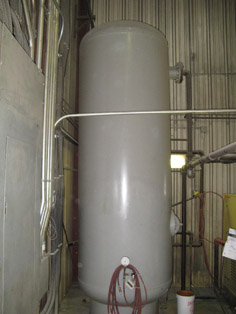
Large storage helps screw compressors run more efficiently.
If you have one or more lubricated screw compressors that run partially loaded in load/unload mode, the size of the storage receiver is quite important to the compressor operating efficiency—and may affect its lifespan. If your compressors run in modulation mode, the least efficient way to run a screw compressor, the compressor efficiency is likely very poor, often operators are forced to select modulation mode due to the lack of receiver capacity in a system. And even if you operate a VSD controlled compressor, the most efficient way to run screw compressors, some storage capacity is still of benefit.
Load/unload mode is where the compressor alternately goes to its fully loaded condition when a lower pressure set point is reached, and then unloads at a higher set point, with the unloaded compressor remaining running, but producing no air. An unloaded compressor typically consumes much less power, about 30% of full load, than a compressor that is running partly loaded in modulation mode, which might consume 70% of full load when at zero output.
If a load/unload compressor is, say, 50% loaded, it will spend 50% of the time fully loaded and 50% of the time in unloaded state. At 50% duty, the compressor will be loading and unloading at its maximum frequency, and the frequency of these cycles depends on how much storage receiver capacity is available to the compressor.
If the compressor has a 10 psi pressure band, and only one USG of storage capacity per rated cfm output, it will load and unload once every 22 seconds, or more than 160 times an hour. This is a problem because when lubricated screw compressors unload, it usually takes between 40 and 120 seconds to reach the lower 30% power level—and during this transition, it is consuming more power than needed.
When lubricated screw compressors unload, some already-compressed air is vented from its internal oil sump as the sump is blown down to lower pressure. It is through this lower pressure the compressor achieves lower unloaded power. But the vented air has just been compressed 11 seconds earlier, this frequent compressing and venting wastes energy. Therefore, with low system storage receiver capacity, lubricated compressors operate less efficiently.
If larger storage capacity is installed, say 6 gal per cfm, the compressor cycle frequency will be 6 times less, resulting in only 27 cycles per hour. At 50% load a compressor with this storage size would stay unloaded for more than one minute before having to load for another cycle. These reduced cycles make the compressor run about 20% more efficiently and helps extend the compressor life due to less cycle stress on the bearings.
If you have a variable speed drive controlled compressor, some storage is still required to help stabilize the compressor control and to reduce load/unload or start/stop cycle frequency—if the compressor has to run below its minimum speed at any time.
Why don’t more systems have large storage installed? It’s usually because this would result in higher initial purchase price. But, if long term operating cost is considered the increase in storage capacity will usually pay for itself if reduced electricity costs alone in less than two years.
And there are other benefits to large storage, like stabilizing your pressure, protecting your air dryer from excessive temperatures or flows, and possibly reducing the number of running compressors needed that could save even more.
Filed Under: Fluid Power Basics, Pneumatic Tips